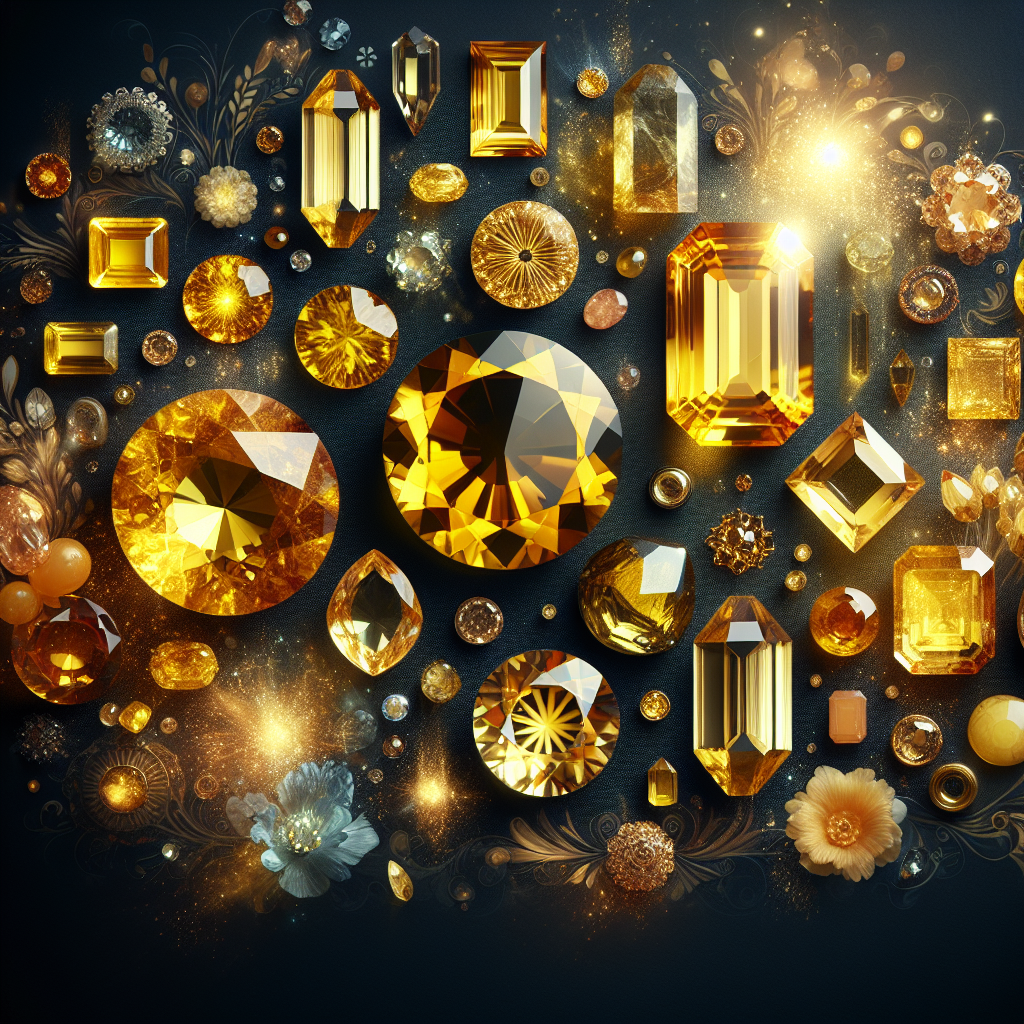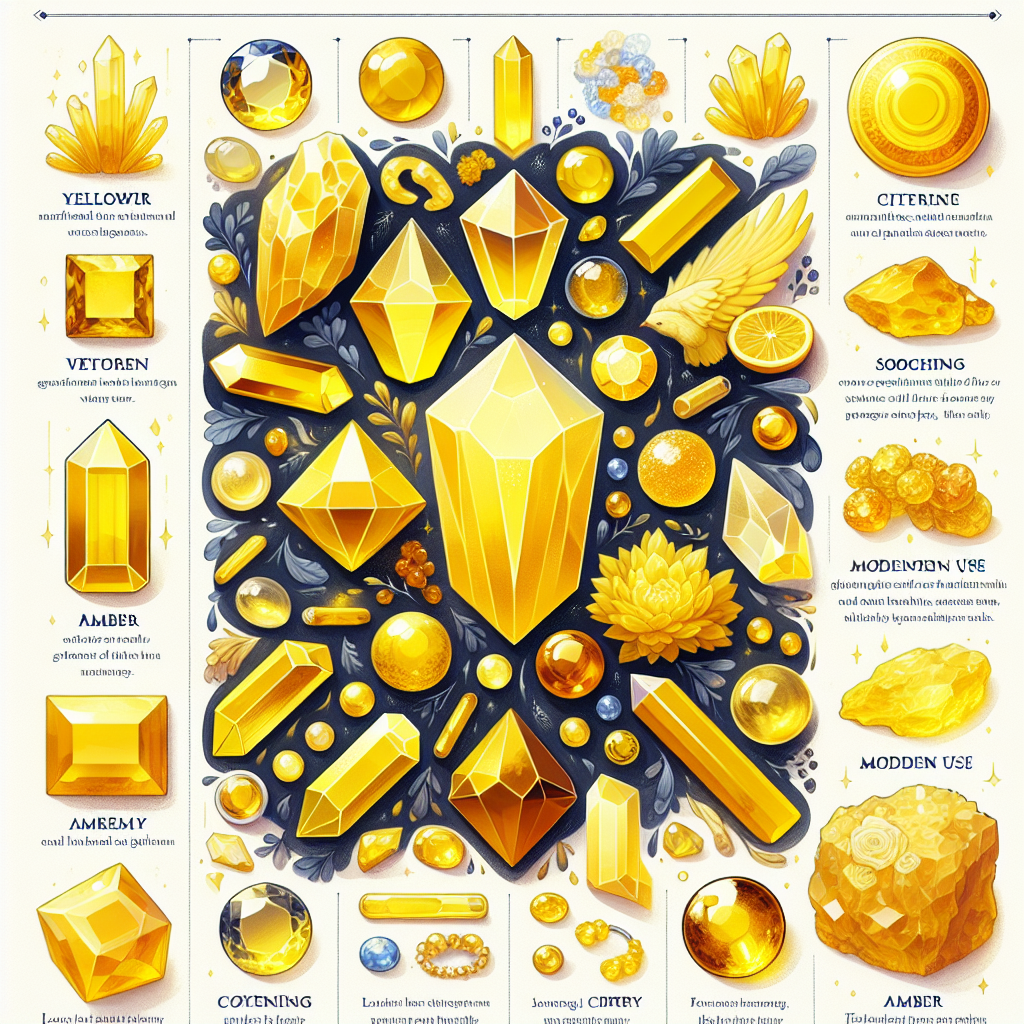
Imagine adorning yourself with the vibrant and energizing hues of yellow gemstones and crystals. From the radiant sunshine yellow of citrine to the golden glow of amber, these dazzling gemstones hold the power to enhance your aura and bring positivity into your life. In this comprehensive guide, we will explore the properties and meanings behind 16 top yellow gemstones and crystals. From their origins to their unique metaphysical properties, get ready to embark on a journey through the mesmerizing world of yellow gemstones and crystals. Enhance your spiritual well-being and indulge in their unparalleled beauty as we unravel the secrets of these enchanting treasures.
Introduction to Yellow Gemstones and Crystals
Yellow gemstones and crystals are a captivating and popular choice in the world of gemstone enthusiasts. Their vibrant and warm hues make them highly sought after for jewelry and holistic purposes. The significance of yellow gemstones goes beyond their stunning appearance, as they are believed to possess unique healing properties and spiritual benefits. In this comprehensive guide, we will delve into the different types of yellow gemstones, their properties, benefits, as well as their use in astrology, feng shui, and energy healing. Whether you are a gemstone connoisseur or simply drawn to their beauty, this guide will provide you with valuable insights into the world of yellow gemstones.
Types of Yellow Gemstones

Citrine
Citrine is a captivating yellow gemstone that is known for its vibrant energy and numerous positive attributes. With its warm yellow hues, citrine is often associated with abundance, prosperity, and joy. This gemstone is a variety of quartz and is renowned for its radiant appearance. Citrine is widely used in jewelry, and its properties and benefits make it a popular choice among crystal enthusiasts.
Properties and characteristics of citrine
Citrine is renowned for its beautiful yellow color, which ranges from pale yellow to deep amber. The gemstone’s color is often attributed to the presence of iron impurities and the heat treatment process. Natural citrine is relatively rare, and most commercially available citrine is heat-treated amethyst or smoky quartz.
In terms of hardness, citrine has a rating of 7 on the Mohs scale. This makes it a durable gemstone suitable for various jewelry designs. Its luster is vitreous and gives citrine a brilliant shine when cut and polished.
Benefits and uses of citrine
Citrine is believed to possess numerous benefits that resonate with different aspects of life. This gemstone is often associated with fostering creativity, abundance, and personal power. Many people believe that citrine can attract wealth and success while promoting a positive mindset.
In addition to its metaphysical properties, citrine is also favored for its ability to energize and cleanse other gemstones. It is often used in combination with other crystals to amplify their properties. Citrine is also used in alternative healing practices such as crystal therapy and chakra balancing.
Topaz
Topaz is another delightful yellow gemstone that has captured the hearts of gemstone enthusiasts for centuries. Its dazzling golden hues symbolize warmth, clarity, and positivity, making it a popular choice for jewelry and spiritual practices. Topaz is a versatile gemstone that comes in a variety of colors, with yellow being one of the most desired.
Properties and characteristics of topaz
Natural yellow topaz is rare, and most yellow topaz seen in jewelry today is heat-treated or irradiated to achieve its vibrant color. Topaz is known for its excellent clarity, which allows light to pass through and create a brilliant sparkle. It has a hardness rating of 8 on the Mohs scale, making it a durable gemstone suitable for everyday wear.
Topaz is often found in large sizes, which makes it a favored gemstone for statement jewelry pieces. Its luster is often described as vitreous or glass-like, adding to its allure.
Benefits and uses of topaz
Topaz is believed to have various metaphysical properties that can benefit the wearer. It is often associated with enhancing positive traits such as confidence, self-esteem, and creativity. The golden hues of yellow topaz are also associated with abundance and prosperity.
In addition to its metaphysical benefits, topaz is also known for its physical healing properties. It is believed to help in reducing stress, promoting relaxation, and aiding in digestion. Topaz is often used in alternative healing practices such as crystal therapy and Reiki.
Amber
Amber, often referred to as “the gold of the sea,” is a unique yellow gemstone that has been treasured for its warmth and beauty for centuries. Unlike other gemstones, amber is not mineral-based but originated from ancient tree resin that fossilized over millions of years. Its mesmerizing golden hues and organic origins make it a favorite among jewelry enthusiasts and collectors.
Properties and characteristics of amber
Amber is characterized by its warm golden to deep yellow hues, often reminiscent of the sun. Its organic origins give it a unique feel and a sense of history. Amber is relatively soft compared to other gemstones, with a hardness rating of 2 to 2.5 on the Mohs scale.
Amber is renowned for its inclusion of ancient plant matter and often possesses fascinating natural formations, such as trapped insects and debris. These inclusions add to its beauty and give each piece of amber a story of its own.
Benefits and uses of amber
Amber is believed to possess various healing properties and is often associated with promoting good health and wellbeing. It is believed to have a calming effect on the mind and body, reducing stress and promoting relaxation. Amber is also believed to help relieve pain and inflammation, making it a popular choice for holistic healing.
In addition to its healing properties, amber is widely used in jewelry and is prized for its unique appearance. Amber beads, pendants, and earrings are favored for their warm glow and ability to add a touch of timeless beauty to any outfit.
Yellow Sapphire
Yellow sapphire, also known as “Pukhraj,” is a precious gemstone that exudes elegance and sophistication. It is revered for its brilliant yellow hues and is associated with prosperity, wisdom, and spiritual growth. Yellow sapphire is a variety of corundum, the same mineral that forms rubies and sapphires of other colors.
Properties and characteristics of yellow sapphire
Yellow sapphire is characterized by its vibrant yellow color, which ranges from pale to intense golden hues. The intensity of its color is often the most prized factor when evaluating the quality of yellow sapphire. It has a hardness rating of 9 on the Mohs scale, making it one of the hardest gemstones available.
In terms of luster, yellow sapphire possesses a vitreous sheen that adds to its overall brilliance. The gemstone’s clarity is also highly valued, as clean and transparent yellow sapphires are considered more desirable.
Benefits and uses of yellow sapphire
Yellow sapphire is believed to possess numerous metaphysical properties that can benefit the wearer. It is often associated with attracting wealth, abundance, and overall success. The gemstone is also believed to enhance clarity of thought, promote spiritual growth, and provide protection against negative energies.
In addition to its metaphysical properties, yellow sapphire is also used in alternative healing practices. It is believed to help improve digestion, boost vitality, and enhance overall well-being. Many people wear yellow sapphire jewelry as a way to connect with its positive energies.
Stay tuned for Part 2 of this comprehensive guide, where we will explore the healing properties of yellow gemstones, how to choose and care for them, and the popular yellow gemstone jewelry options available.


